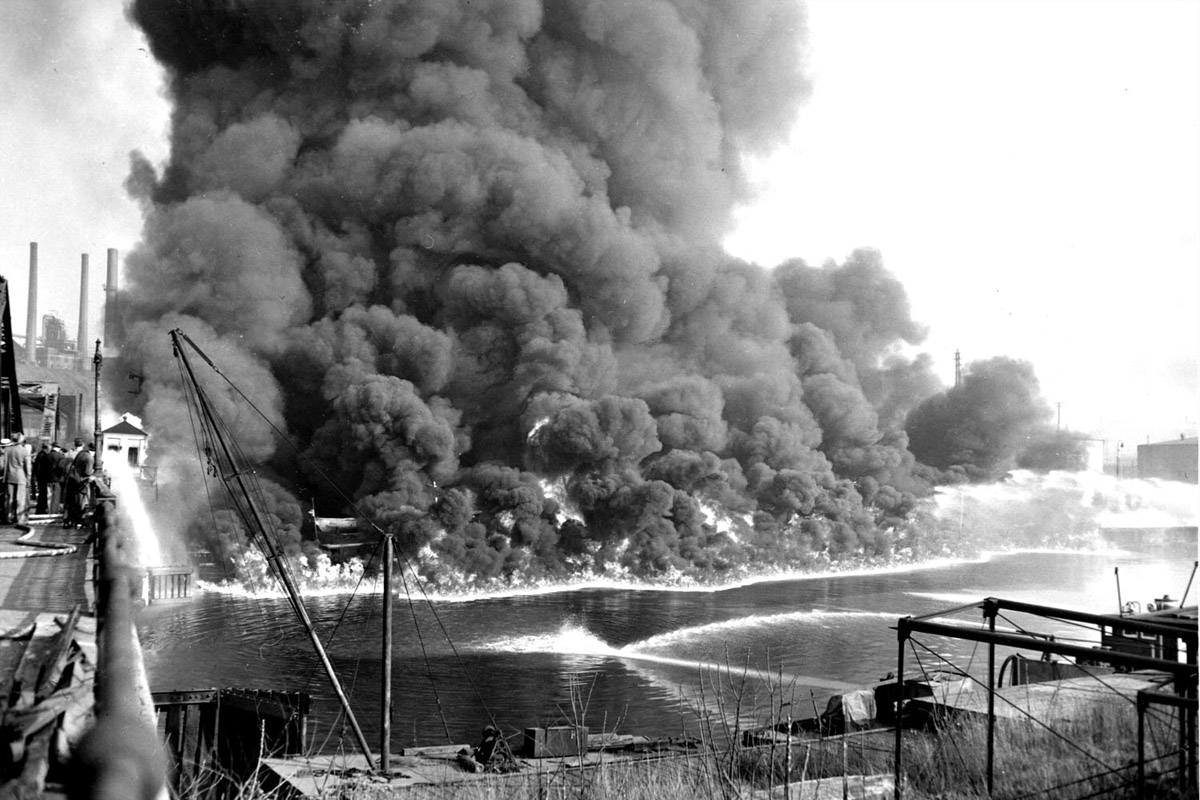NOTE: This story was originally published on April 17, 2015.
At the time of the first Earth Day in 1970, the Cuyahoga River had long been a pollution problem. Cleveland had been a major industrial city since the 1880s, and the mayor then called the river “an open sewer through the center of the city.”
But when the Cuyahoga River caught fire in Cleveland in 1969, many believe it became the symbol of out-of-control pollution that was needed to get the Clean Water Act passed.
The word “cuyahoga” means crooked. When you look at a map, the Cuyahoga’s path forms a U-shape—beginning in northeastern Geauga County, running south and west, through Akron, then turning back north to Cleveland on Lake Erie.
And in the late 1960s, those last few miles leading to Lake Erie were lined with steel mills and factories. At that time, little had been done to stop the pollution.
“What I really remember was going out on a boat that takes people on river and Lake Erie tours,” says Cleveland-native Frank Greenland of the Northeast Ohio Regional Sewer District. “And there were fairly big algal blooms going on at that time, and a lot of dead and dying fish. Not a great memory.”
LISTEN: “How the Cuyahoga River Fire Helped Create the Clean Water Act”
Environmental activist Elaine Marsh says her first visit to Lake Erie left her with similar memories. “There were all kinds of signs—’No swimming,’ ‘No boating,’ ‘Use at your own risk,’ ‘Polluted water.’ It didn’t even look like water. It looked like oil and grease and paint.”
Most people blamed industry.
“All of the industries, including in Akron, just dumped their waste in the river—untreated,” remembers Ben Stefanski, who was 28 when he was hired as utilities director of Cleveland. “That’s was just what the river was there for. We didn’t think about the future.”
For Stefanski and many others, that changed on June 22, 1969—the day the Cuyahoga River caught fire. In a way, this was nothing new: The river had burned at least a dozen times before, costing millions, and even killing five people.
But 1969 was different.
WATCH: “The Cuyahoga River Fire of 1969”
Newly elected President Richard Nixon had made air and water pollution top priorities. And other issues were boiling over around the country. The Vietnam War. In Cleveland, there were race riots.
“The mayor was Mayor Carl Stokes,” Stefanski says. “So, you know, black mayor of a major city—the national press had their reporters here 24 hours a day. Anything that happened in the city, no matter how small, it was reported on by the press. They were living here so they had to tell the story.”
A few months after the fire, Time magazine picked up the story and ran a photo of an earlier, much worse fire. Elaine Marsh says that’s when Cleveland’s burning water shot to national prominence.
“It was a river catching fire,” she says. “I think the rest of the country looked at it and was just—that’s it. That’s over the top. Something has to be done.”
Initially, that something was Mayor Stokes using the attention to raise money to clean up the water.
“Carl became a national spokesman,” says Ben Stefanski. “He went to Washington, he was before Congress. He was from Cleveland—the city that had dirty water. Plus, he was a black person, so he represented that whole community that was in the inner city that lived along the lake and the rivers.”
The Cuyahoga River has caught fire a total of 13 times dating back to 1868. But the fire in 1969, helped spur action that ultimately led to the passage of the Clean Water Act in 1972.
Later that year, Congress passed the National Environmental Policy Act. It was the precursor to the Environmental Protection Agency, which was established in 1970—the year of the first Earth Day. Elaine Marsh remembers that first Earth Day celebration in 1970. She was setting up a table for the Sierra Club at the University of Akron, expecting few people to show up. But they kept coming.
“Church groups, school groups, Cub Scouts, Girl Scouts—it was really amazing. I thought it was going to be four or five tables of people I knew—you know, the usual suspects. And I was really astonished to see all of the people who were so interested and active.”
Historian David Stradling, author of the book Where the River Burned, says Mayor Stokes didn’t attend Earth Day events. But he continued to speak out on environmental issues.
“He did call politicians kind of frauds on Earth Day—being out there, making speeches about the importance of investing in the environment, and at the same time, going back to Washington and dedicating very little money for this very purpose,” Stradling says.
Indeed, President Nixon, who generally supported environmental clean-up efforts, vetoed a bill passed by Congress to create national water quality standards because of the high price tag. Congress overrode his veto. That law was the Clean Water Act.

